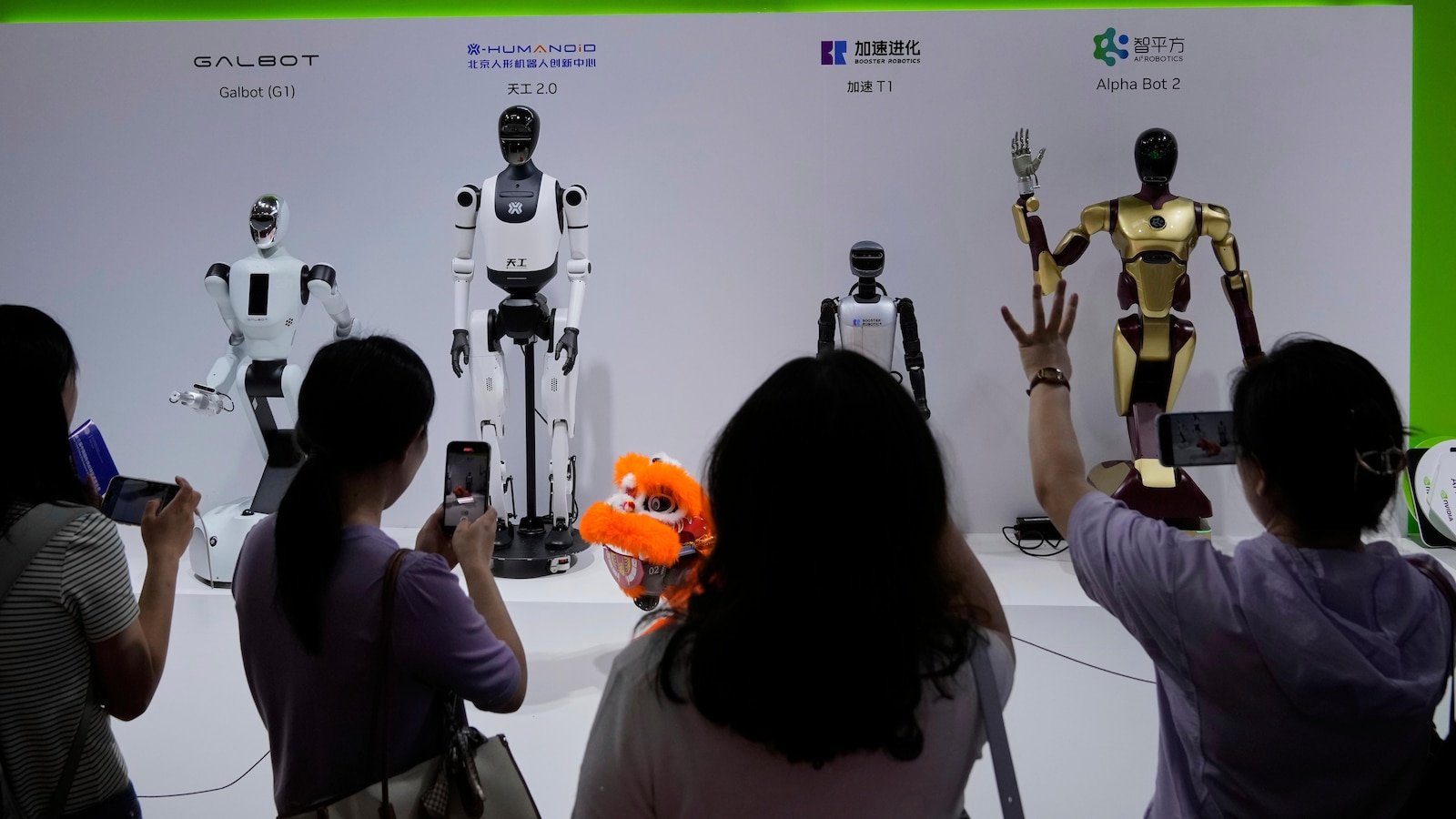AI Insights
Nvidia’s quarterly report will gauge the temperature of the AI craze

SAN FRANCISCO — Artificial intelligence bellwether Nvidia is poised to release a quarterly report that’s expected provide a better sense about whether the stock market has been riding on an overhyped bubble or whether it’s being propelled by a technological boom that’s still gathering momentum.
The financial results due out Wednesday afternoon have become a key AI barometer during the past two years because Nvidia makes most of the chips that power the technology in vast data centers scattered throughout the boom. Nvidia become the first publicly traded company to surpass a market value of $4 trillion last month, and its stock price has gained another 13% since then to create an additional $500 billion in shareholder wealth.
This summer’s run-up has continued Nvidia’s jaw-dropping rise from early 2023, when the company’s market value was hovering around $400 billion, shortly after OpenAI’s late 2022 release of its ChatGPT chatbot triggered the biggest craze in technology since Apple released the first iPhone in 2007.
While the technology industry has been the biggest beneficiary of the AI frenzy, it’s also been a boon for the overall stock market. The benchmark S&P 500 has gained 68% since the end of 2022, with AI fervor fueling much of the investor optimism.
But even amid the general euphoria, there recently have been murmurs about whether AI mania will prove to be an echo of the late 1990s dot-com boom that culminated in an excruciating stock market meltdown in 2000 that eventually drove the U.S. economy and plunged Silicon Valley into a funk that lasted several years before the tech industry began to thrive again.
Investors were recently spooked by a combination of an MIT report that said 95% of AI pilots fail and comments from OpenAI CEO Sam Altman floating the idea that the artificial intelligence market is in a bubble.
And by some metrics, the stock prices of tech companies at the AI are looking frothy. For instance, Nvidia is trading at about 40 times its future earnings, roughly double the rate that investors traditionally believe is a reasonable level. Meanwhile, the market value of Microsoft, another AI leader, is hovering just below $4 trillion, while the values of other fellow pacesetters Amazon, Facebook parent Meta Platforms and Google parent Alphabet currently range from $1.9 trillion to $2.5 trillion.
Nvidia is expected to post another quarter of robust growth for the May-July period of its fiscal year. Analysts surveyed by FactSet research predict Nvidia will earn $1.01 per share, excluding certain items unrelated to its ongoing business, which would be a 49% increase from the same time last year. The analysts anticipated Nvidia’s revenue would rise 53% from a year ago to about $46 billion.
Those gains reflect the financial tsunami flooding the AI market as the biggest players spend heavily to build and expand data centers needed to power the technology. Microsoft, Amazon, Alphabet and Meta are collectively budgeting more than $325 billion for investments in AI this year. With its dominant position in the AI chip market, Nvidia is reaping the benefits of that intense demand.
Even so, the trajectory of Nvidia’s growth has been tapering off. If analyst projections pan out, Nvidia’s revenue growth for its latest quarter will be significantly lower than the 122% increase it posted during the same period last year.
And Nvidia has also been losing business because of President Donald Trump’s trade war with China. Following a ban on its AI chip sales in China, which resulted in a $4.5 billion blow to its finances during its fiscal first quarter, Nvidia estimated that the restrictions would cost it about approximately $8 billion in sales in this during the past quarter.
Trump took the China handcuffs off of Nvidia earlier this month in return for a 15% cut of the company’s sales in that country — a compromise CEO Jensen Huang is expected to discuss with analysts while he shares his perspective on the state of the AI market on a call with investors.
AI Insights
Varo Bank Appoints Asmau Ahmed as Chief Artificial Intelligence Officer to Drive AI Innovation

Varo Bank has hired Asmau Ahmed as its first Chief Artificial Intelligence and Data Officer (CAIDO) to lead company-wide AI and machine-learning efforts. Ahmed has over 20 years of experience in leading teams and delivering products at Google X, Bank of America, Capital One, and Deloitte. She will focus on advancing Varo’s mission-driven tech evolution and improving customers’ financial experiences through AI. Varo uses AI to enhance its credit-decisioning processes, and Ahmed’s expertise will help guide future institution-wide advancements in AI.
Title: Varo Bank Appoints Asmau Ahmed as Chief Artificial Intelligence and Data Officer
Varo Bank, the first all-digital nationally chartered bank in the U.S., has announced the hiring of Asmau Ahmed as its first Chief Artificial Intelligence and Data Officer (CAIDO). Ahmed, who brings over 20 years of expertise in innovation from Google, Bank of America, and Capital One, will lead the company’s AI and machine-learning efforts, reporting directly to CEO Gavin Michael [1].
Ahmed’s appointment comes as Varo Bank continues to leverage AI to enhance its core functions. The bank has expanded credit access by using data and advanced machine learning-driven decisioning, reinforcing its mission of advancing financial inclusion with technology. The Varo Line of Credit, launched in 2024, uses self-learning models to improve its credit-decisioning processes based on proprietary algorithms, allowing some customers with reliable Varo banking histories access to loans that traditional credit score systems would have excluded [1].
Ahmed’s extensive experience includes leading technology, portfolio, and customer-facing product teams at Bank of America and Capital One, as well as co-leading the Digital Innovation team at Deloitte. She has also founded a visual search advertising tech company, Plum Perfect. Her expertise will be instrumental in guiding Varo Bank’s future advancements in AI.
“As a nationally-chartered bank, Varo is able to use data and AI in an innovative way that stands out across the finance industry,” said Ahmed. “Today we are applying machine learning for underwriting, as well as fraud prevention and detection. I am thrilled to lead the next phase of Varo’s mission-driven tech evolution and ensure AI can improve our customers’ experiences and financial lives” [1].
Varo Bank’s AI and data science efforts are designed to enhance various core functions of the company’s tech stack. The appointment of Ahmed as CAIDO underscores the bank’s commitment to leveraging AI to improve customer experiences and financial outcomes.
References
[1] https://www.businesswire.com/news/home/20250904262245/en/Varo-Bank-to-Accelerate-Responsible-and-Customer-Focused-AI-Efforts-with-New-Chief-Artificial-Intelligence-Officer-Asmau-Ahmed
AI Insights
Guest column—University of Tennessee “Embraces” Artificial Intelligence, Downplays Dangers – The Pacer
At the end of February, the University of Tennessee Board of Trustees adopted its first artificial intelligence policy.
The board produced its policy statement with little attempt to engage faculty and students in meaningful discussions about the serious problems that may arise from AI.
At UT Martin, the Faculty Senate approved the board’s policy statement in late April, also without significant input from faculty or students.
In Section V of the document, “Policy Statement and Guiding Principles,” the first subsection states: “UT Martin embraces the use of AI as a powerful tool for the purpose of enhancing human learning, creativity, analysis, and innovation within the academic context.”
The document notes potential problems such as academic integrity, the compromise of intellectual property rights and the security of protected university data. But it does not address what may be the most dangerous and most likely consequence of AI’s rapid growth: the limiting of human learning, creativity, analysis and innovation.
Over the past two years, faculty in the humanities have seen students increasingly turn to AI, even for low-stakes assignments. AI allows students to bypass the effort of trying to understand a reading.
If students attempt a difficult text and struggle to make sense of it, they can ask AI to explain. More often, however, students skip reading altogether and ask AI for a summary, analysis or other grade-directed answers.
In approaching a novel, a historical narrative or even the social realities of our own time, readers start with limited knowledge of the characters, events or forces at play. To understand a character’s motives, the relationship between events, or the social, economic and political interests driving them, we must construct and refine a mental image—a hypothesis—through careful reading.
This process is the heart of education. Only by grappling with a text, a formula or a method for solving a problem do we truly learn. Without that effort, students may arrive at the “right” answer, but they have not gained the tools to understand the problems they face—or to live morally and intelligently in the world.
As complex as a novel or historical narrative may be, the real world is far more complex. If we rely on AI’s interpretation instead of building our own understanding, we deprive ourselves of the skills needed to engage with that complexity.
UT Martin’s mission statement says: “The University of Tennessee at Martin educates and engages responsible citizens to lead and serve in a diverse world.” Yet we fail this mission in many ways. Most students do not follow current events and are unaware of pressing issues. Few leave the university with a love of reading, despite its importance to responsible citizenship.
With this new AI policy, the university risks compounding these failures by embracing a technology that may further erode students’ ability to think critically about the world around them.
AI Insights
Artificial intelligence can predict risk of heart attack – The Anniston Star
-

 Business6 days ago
Business6 days agoThe Guardian view on Trump and the Fed: independence is no substitute for accountability | Editorial
-
Tools & Platforms3 weeks ago
Building Trust in Military AI Starts with Opening the Black Box – War on the Rocks
-

 Ethics & Policy1 month ago
Ethics & Policy1 month agoSDAIA Supports Saudi Arabia’s Leadership in Shaping Global AI Ethics, Policy, and Research – وكالة الأنباء السعودية
-

 Events & Conferences4 months ago
Events & Conferences4 months agoJourney to 1000 models: Scaling Instagram’s recommendation system
-

 Jobs & Careers2 months ago
Jobs & Careers2 months agoMumbai-based Perplexity Alternative Has 60k+ Users Without Funding
-

 Education2 months ago
Education2 months agoVEX Robotics launches AI-powered classroom robotics system
-

 Funding & Business2 months ago
Funding & Business2 months agoKayak and Expedia race to build AI travel agents that turn social posts into itineraries
-

 Podcasts & Talks2 months ago
Podcasts & Talks2 months agoHappy 4th of July! 🎆 Made with Veo 3 in Gemini
-

 Podcasts & Talks2 months ago
Podcasts & Talks2 months agoOpenAI 🤝 @teamganassi
-

 Education2 months ago
Education2 months agoMacron says UK and France have duty to tackle illegal migration ‘with humanity, solidarity and firmness’ – UK politics live | Politics






















